Digital signatures are the public-key primitives of message authentication. In the physical world, it is common to use handwritten signatures on handwritten or typed messages. They are used to bind signatory to the message.
Similarly, a digital signature is a technique that binds a person/entity to the digital data. This binding can be independently verified by receiver as well as any third party.
Digital signature is a cryptographic value that is calculated from the data and a secret key known only by the signer.
In real world, the receiver of message needs assurance that the message belongs to the sender and he should not be able to repudiate the origination of that message. This requirement is very crucial in business applications, since likelihood of a dispute over exchanged data is very high.
Model of Digital Signature
As mentioned earlier, the digital signature scheme is based on public key cryptography. The model of digital signature scheme is depicted in the following illustration −
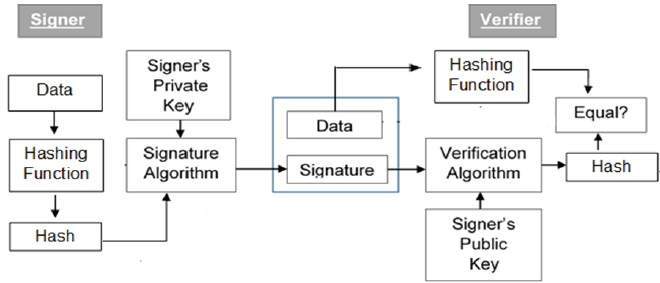
The following points explain the entire process in detail −
- Each person adopting this scheme has a public-private key pair.
- Generally, the key pairs used for encryption/decryption and signing/verifying are different. The private key used for signing is referred to as the signature key and the public key as the verification key.
- Signer feeds data to the hash function and generates hash of data.
- Hash value and signature key are then fed to the signature algorithm which produces the digital signature on given hash. Signature is appended to the data and then both are sent to the verifier.
- Verifier feeds the digital signature and the verification key into the verification algorithm. The verification algorithm gives some value as output.
- Verifier also runs same hash function on received data to generate hash value.
- For verification, this hash value and output of verification algorithm are compared. Based on the comparison result, verifier decides whether the digital signature is valid.
- Since digital signature is created by ‘private’ key of signer and no one else can have this key; the signer cannot repudiate signing the data in future.
It should be noticed that instead of signing data directly by signing algorithm, usually a hash of data is created. Since the hash of data is a unique representation of data, it is sufficient to sign the hash in place of data. The most important reason of using hash instead of data directly for signing is efficiency of the scheme.
Let us assume RSA is used as the signing algorithm. As discussed in public key encryption chapter, the encryption/signing process using RSA involves modular exponentiation.
Signing large data through modular exponentiation is computationally expensive and time consuming. The hash of the data is a relatively small digest of the data, hence signing a hash is more efficient than signing the entire data.
Importance of Digital Signature
Out of all cryptographic primitives, the digital signature using public key cryptography is considered as very important and useful tool to achieve information security.
Apart from ability to provide non-repudiation of message, the digital signature also provides message authentication and data integrity. Let us briefly see how this is achieved by the digital signature −
- Message authentication − When the verifier validates the digital signature using public key of a sender, he is assured that signature has been created only by sender who possess the corresponding secret private key and no one else.
- Data Integrity − In case an attacker has access to the data and modifies it, the digital signature verification at receiver end fails. The hash of modified data and the output provided by the verification algorithm will not match. Hence, receiver can safely deny the message assuming that data integrity has been breached.
- Non-repudiation − Since it is assumed that only the signer has the knowledge of the signature key, he can only create unique signature on a given data. Thus the receiver can present data and the digital signature to a third party as evidence if any dispute arises in the future.
By adding public-key encryption to digital signature scheme, we can create a cryptosystem that can provide the four essential elements of security namely − Privacy, Authentication, Integrity, and Non-repudiation.
Encryption with Digital Signature
In many digital communications, it is desirable to exchange an encrypted messages than plaintext to achieve confidentiality. In public key encryption scheme, a public (encryption) key of sender is available in open domain, and hence anyone can spoof his identity and send any encrypted message to the receiver.
This makes it essential for users employing PKC for encryption to seek digital signatures along with encrypted data to be assured of message authentication and non-repudiation.
This can archived by combining digital signatures with encryption scheme. Let us briefly discuss how to achieve this requirement. There are two possibilities, sign-then-encrypt and encrypt-then-sign.
However, the crypto system based on sign-then-encrypt can be exploited by receiver to spoof identity of sender and sent that data to third party. Hence, this method is not preferred. The process of encrypt-then-sign is more reliable and widely adopted. This is depicted in the following illustration −
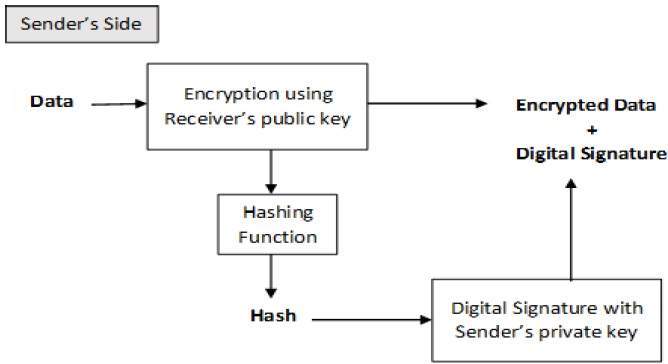
The receiver after receiving the encrypted data and signature on it, first verifies the signature using sender’s public key. After ensuring the validity of the signature, he then retrieves the data through decryption using his private key.
Publc Key Infrastructure (PKI) and Digital Certificates
The most distinct feature of Public Key Infrastructure (PKC) is that it uses a pair of keys to achieve the underlying security service. The key pair comprises of private key and public key.
Since the public keys are in open domain, they are likely to be abused. It is, thus, necessary to establish and maintain some kind of trusted infrastructure to manage these keys.
Key Management
It goes without saying that the security of any cryptosystem depends upon how securely its keys are managed. Without secure procedures for the handling of cryptographic keys, the benefits of the use of strong cryptographic schemes are potentially lost.
It is observed that cryptographic schemes are rarely compromised through weaknesses in their design. However, they are often compromised through poor key management.
There are some important aspects of key management which are as follows −
- Cryptographic keys are nothing but special pieces of data. Key management refers to the secure administration of cryptographic keys.
- Key management deals with entire key lifecycle as depicted in the following illustration −
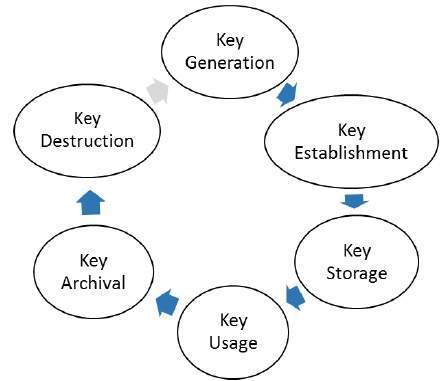
- There are two specific requirements of key management for public key cryptography.
- Secrecy of private keys. Throughout the key lifecycle, secret keys must remain secret from all parties except those who are owner and are authorized to use them.
- Assurance of public keys. In public key cryptography, the public keys are in open domain and seen as public pieces of data. By default there are no assurances of whether a public key is correct, with whom it can be associated, or what it can be used for. Thus key management of public keys needs to focus much more explicitly on assurance of purpose of public keys.
The most crucial requirement of ‘assurance of public key’ can be achieved through the public-key infrastructure (PKI), a key management systems for supporting public-key cryptography.
Public Key Infrastructure (PKI)
PKI provides assurance of public key. It provides the identification of public keys and their distribution. An anatomy of PKI comprises of the following components.
- Public Key Certificate, commonly referred to as ‘digital certificate’.
- Private Key tokens.
- Certification Authority.
- Registration Authority.
- Certificate Management System.
Digital Certificate
For analogy, a certificate can be considered as the ID card issued to the person. People use ID cards such as a driver’s license, passport to prove their identity. A digital certificate does the same basic thing in the electronic world, but with one difference.
Digital Certificates are not only issued to people but they can be issued to computers, software packages or anything else that need to prove the identity in the electronic world.
- Digital certificates are based on the ITU standard X.509 which defines a standard certificate format for public key certificates and certification validation. Hence digital certificates are sometimes also referred to as X.509 certificates.Public key pertaining to the user client is stored in digital certificates by The Certification Authority (CA) along with other relevant information such as client information, expiration date, usage, issuer etc.
- CA digitally signs this entire information and includes digital signature in the certificate.
- Anyone who needs the assurance about the public key and associated information of client, he carries out the signature validation process using CA’s public key. Successful validation assures that the public key given in the certificate belongs to the person whose details are given in the certificate.
The process of obtaining Digital Certificate by a person/entity is depicted in the following illustration.
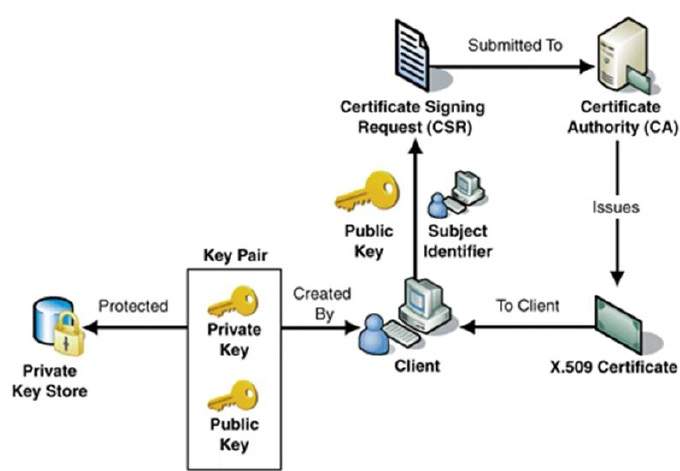
As shown in the illustration, the CA accepts the application from a client to certify his public key. The CA, after duly verifying identity of client, issues a digital certificate to that client.
Certifying Authority (CA)
As discussed above, the CA issues certificate to a client and assist other users to verify the certificate. The CA takes responsibility for identifying correctly the identity of the client asking for a certificate to be issued, and ensures that the information contained within the certificate is correct and digitally signs it.
Key Functions of CA
The key functions of a CA are as follows −
- Generating key pairs − The CA may generate a key pair independently or jointly with the client.
- Issuing digital certificates − The CA could be thought of as the PKI equivalent of a passport agency − the CA issues a certificate after client provides the credentials to confirm his identity. The CA then signs the certificate to prevent modification of the details contained in the certificate.
- Publishing Certificates − The CA need to publish certificates so that users can find them. There are two ways of achieving this. One is to publish certificates in the equivalent of an electronic telephone directory. The other is to send your certificate out to those people you think might need it by one means or another.
- Verifying Certificates − The CA makes its public key available in environment to assist verification of his signature on clients’ digital certificate.
- Revocation of Certificates − At times, CA revokes the certificate issued due to some reason such as compromise of private key by user or loss of trust in the client. After revocation, CA maintains the list of all revoked certificate that is available to the environment.
Classes of Certificates
There are four typical classes of certificate −
- Class 1 − These certificates can be easily acquired by supplying an email address.
- Class 2 − These certificates require additional personal information to be supplied.
- Class 3 − These certificates can only be purchased after checks have been made about the requestor’s identity.
- Class 4 − They may be used by governments and financial organizations needing very high levels of trust.
Registration Authority (RA)
CA may use a third-party Registration Authority (RA) to perform the necessary checks on the person or company requesting the certificate to confirm their identity. The RA may appear to the client as a CA, but they do not actually sign the certificate that is issued.
Certificate Management System (CMS)
It is the management system through which certificates are published, temporarily or permanently suspended, renewed, or revoked. Certificate management systems do not normally delete certificates because it may be necessary to prove their status at a point in time, perhaps for legal reasons. A CA along with associated RA runs certificate management systems to be able to track their responsibilities and liabilities.
Private Key Tokens
While the public key of a client is stored on the certificate, the associated secret private key can be stored on the key owner’s computer. This method is generally not adopted. If an attacker gains access to the computer, he can easily gain access to private key. For this reason, a private key is stored on secure removable storage token access to which is protected through a password.
Different vendors often use different and sometimes proprietary storage formats for storing keys. For example, Entrust uses the proprietary .epf format, while Verisign, GlobalSign, and Baltimore use the standard .p12 format.
Hierarchy of CA
With vast networks and requirements of global communications, it is practically not feasible to have only one trusted CA from whom all users obtain their certificates. Secondly, availability of only one CA may lead to difficulties if CA is compromised.
In such case, the hierarchical certification model is of interest since it allows public key certificates to be used in environments where two communicating parties do not have trust relationships with the same CA.
- The root CA is at the top of the CA hierarchy and the root CA’s certificate is a self-signed certificate.
- The CAs, which are directly subordinate to the root CA (For example, CA1 and CA2) have CA certificates that are signed by the root CA.
- The CAs under the subordinate CAs in the hierarchy (For example, CA5 and CA6) have their CA certificates signed by the higher-level subordinate CAs.
Certificate authority (CA) hierarchies are reflected in certificate chains. A certificate chain traces a path of certificates from a branch in the hierarchy to the root of the hierarchy.
The following illustration shows a CA hierarchy with a certificate chain leading from an entity certificate through two subordinate CA certificates (CA6 and CA3) to the CA certificate for the root CA.
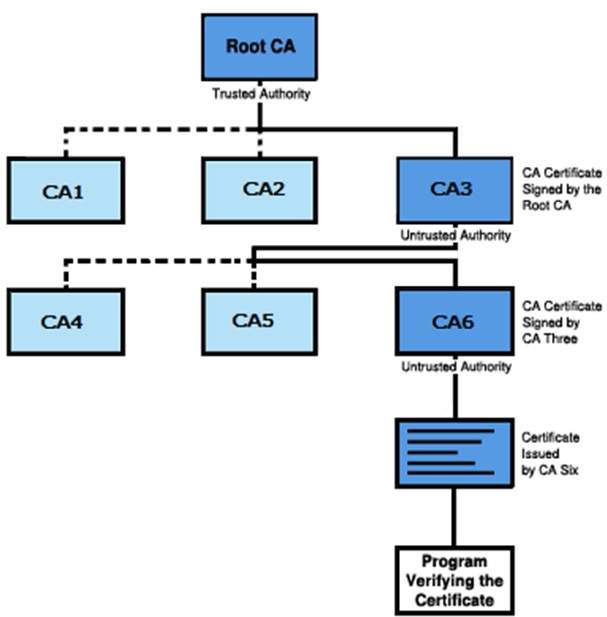
Verifying a certificate chain is the process of ensuring that a specific certificate chain is valid, correctly signed, and trustworthy. The following procedure verifies a certificate chain, beginning with the certificate that is presented for authentication −
- A client whose authenticity is being verified supplies his certificate, generally along with the chain of certificates up to Root CA.
- Verifier takes the certificate and validates by using public key of issuer. The issuer’s public key is found in the issuer’s certificate which is in the chain next to client’s certificate.
- Now if the higher CA who has signed the issuer’s certificate, is trusted by the verifier, verification is successful and stops here.
- Else, the issuer’s certificate is verified in a similar manner as done for client in above steps. This process continues till either trusted CA is found in between or else it continues till Root CA.

4 thoughts on “Digital Signature and Digital Certificate”